Palazzo Spada is a magnificent Renaissance palace named after Cardinal Bernardino Spada.
The cardinal purchased the palace in 1632. He hired famed architect Francesco Borromini to transform the building to beautiful effect.
If you’re wondering whether the off the beaten path Palazzo Spada is worth a visit, the answer is yes — especially if you’ve been to Rome before and seen the main museums.
There are three reasons to put the Palazzo Spada on your itinerary for Rome:
- the beautiful palace itself
- the rare collection of Artemisia Gentileschi paintings
- other Baroque paintings in the Galleria Spada
Here’s my complete guide to visiting Palazzo Spada. It’s a tiny museum and you’ll just need an hour or so.
And, while the rest of Rome is bursting at the seams, Palazzo Spada is a quiet oasis of gorgeous architecture and in situ artworks.
Short History of Palazzo Spada
In 1540, Cardinal Girolamo Capodiferro built the Palazzo Spada, most likely with the help of architect Giulio Mazzoni.
The facade was decorated with statues in niches — mythological figures, famous men from history, and a monumental statue of Pompey the Great. Cardinal Capodiferro died in 1559.
In 1631, Cardinal Bernardino Spada purchased Palazzo Spada, deciding it would be the perfect palace-home. In 1632, Spada hired Borromini to restore and enlarge the building.
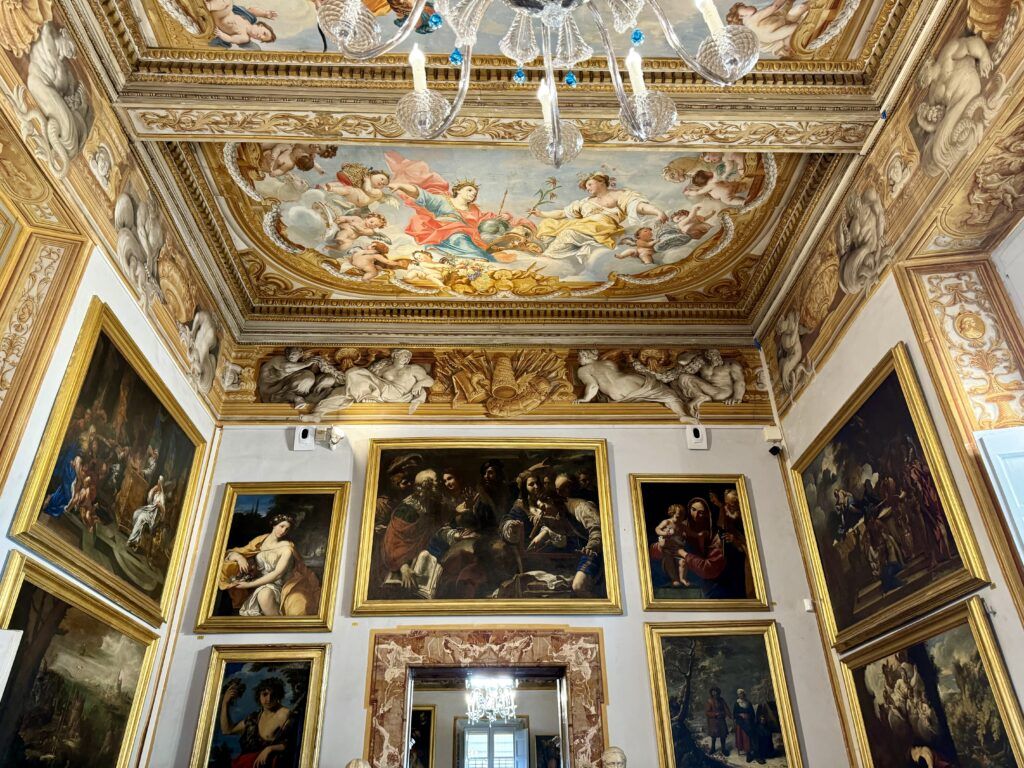
Spada wanted a spacious garden. Because the palace was in the city center, however, there wasn’t much land.
In 1652, he commissioned Borromini to create a perspective folly in the garden courtyard, called the Galleria Prospettica, to provide the illusion of space.
In 1927, the Spada family sold the Palazzo Spada to the Italian State. The bulk of it is used for the Italian Council of State. But the council opened part of the palace as a small museum in 1927, called the Galleria Spada.
Guide To Palazzo Spada: What To See
The Spada family were serious art collectors. The Galleria Spada consists of four sumptuous rooms on the first floor of the piano nobile of the palace.
They’re filled with 16th and 17th century work by Baroque artists like Artemisia Gentileschi, Orazio Gentileschi, Guido Reni, and Titian. Most of the art was collected by Cardinal Bernardino Spada.
The rooms themselves are splendid, decorated with terracotta floors, sumptuous furniture, and painted ceilings.
It’s a rare chance to see art in an ancient quadreria, a gathering of paintings hung on multiple levels of walls as part of a lavish private residence.
The Galleria Doria Pamphilj and Palazzo Barberini are other wonderful examples of this type of intimate museum experience in Rome.
Here are some of the must see highlights:
1. Artemisia Gentileschi, Madonna and Child
Artemisia Gentileschi was one of the most talented painters of the Baroque period, rivaling Caravaggio himself. She painted during the generation after Caravaggio, part of a group called the Caravaggisti.
Living in Florence, a self-made Artemisia became a favorite of rich patrons and royalty.
She filled her bold and expressive canvases with suffering yet fierce heroines from mythology and the bible. Many were self portraits.
Gentileschi’s Madonna and Child is reputedly from her early period.
It’s also sometimes attributed, as so much of Gentileschi’s work was, to other Caravaggisti or antagonists like Giovanni Baglione (a sworn enemy of Caravaggio).
There’s a similar painting by Gentileschi in the Palazzo Pitti In Florence.
But new evidence confirms that the rather homely Spada Madonna and Child is, in fact, Gentileschi’s work. It’s likely a more naturalistic and earthy figure from her early period.
2. Artemisia Gentileschi, Saint Cecelia Playing a Lute
Saint Cecelia is a self portrait of Artemisia Gentileschi, from her early years in Florence. It’s tucked away in a corner of Room 4 and hard to get a good look at.
The artist is playing a lute, making the painting more of an allegory of music than of St. Cecelia. The portable organ behind her confirms St. Cecelia’s identity.
Like the other Madonna painting by Gentileschi, the authorship has been disputed. It was, for a time, even attributed to Caravaggio.
But Cecelia is unmistakably a Gentileschi self-portrait, with her oft used favorite gold color for the drapery of the clothing.
3. Titian, Portait of a Musician
Titian was the supreme genius of Renaissance Venice. He was famous from his 20s. combining High Renaissance and Mannerist ideals.
Titian was a prince’s painter and a painter’s painter. The famous post-Renaissance painters — Rubens, Velazquez, and Rembrandt were devoted to Titian.
Typical of Titian’s paintings, Portrait of a Violinist defines space by color and chiaroscuro (light and dark shading). It may be a portrait of Andrea Vesalius. But Titian’s work from this period is largely undocumented.
The date of the painting is also disputed. Some think it recalls Titian’s early works influenced by another Venetian artist, Giorgione. Other critics say it’s more typical of Titian’s dark and impressionistic paintings from the 1540s.
4. Guido Reni, Portrait of Cardinal Bernardino Spada
Guido Reni was an Italian Baroque painter from Bologna. Reni was a controversial figure, a gambling addict, afraid of witchcraft, women, and poisoning. He adopted the style and uncouth manner of Caravaggio.
Reni only executed a few portraits.
The portraits, like Cardinal Spada above, were distinctive for their luminous and vibrant use of color and naturalistic composition. Though painting in the Baroque, unlike Caravaggio, his work retained a certain classical refinement.
There’s another portrait of the cardinal in the same room by Guercino, just to the left of Reni’s larger version.
5. Orazio Gentileschi, David Contemplating the Head of Goliath
Orazio Gentileschi was a bosom buddy of the notorious outlaw Caravaggio. He was also the less talented father of Artemisia Gentileschi. Nonetheless, he was a noted painter of the Italian Baroque period.
Gentileschi’s painting is a brooding image. Traditionally, the underdog David is shown as a biblical hero or as a triumphant youth holding up Goliath’s head.
Gentileschi’s painting is meditative. David is lost in a moment of deep introspection.
Some critics suggest that the background was painted by Augustino Tassi, a marine landscape painter who raped Orazio’s daughter Artemisia and was tried and convicted (though let off by the pope). You can read the dramatic story of this incident here.
6. Cerrini, David With the Head of Goliath
Born in Perugia, Giovanni Domenico Cerrini moved to Rome in the mid-1630s.
His His style was first influenced by Bolognese classicism, then by the work of Carlo Maratta, a late Baroque painter known for his classicized paintings.
Cerrini’s rendering of the David and Goliath tale is a massive painting. In it, Cerrini depicts Goliath’s head as much larger than David’s, which reflects a literal reading of the bible. The statuesque posture of David is a mark of Cerrini’s style.
7. Pietro Testa, An Allegory on the Massacre of the Innocents,
Testa’s painting of the biblical theme of the Massacre of the Innocents departs from the usual gruesome rendition.
He infuses the terrible event with a more poetic aura, consistent with his mythological pieces. Though the composition is a bit arbitrary, Testa’s colors are luminous.
8. Marble Bust of Laocoon
Bernini admired the ancient sculpture Laocoon, on display in the Vatican Museums. Lacocoon was a Trojan priest who was strangled by snakes sent by angry gods after he sounded the alarm about the Trojan horse trap.
Bernini believed the sculpture was the perfect expression of nature and emotion, without the formal affection of high art.
The bust bears some similarity to Bernini’s bust of Medusa in the Capitoline Museums. But it hasn’t been authenticated as an autograph Bernini.
READ: Bernini Guide To Rome
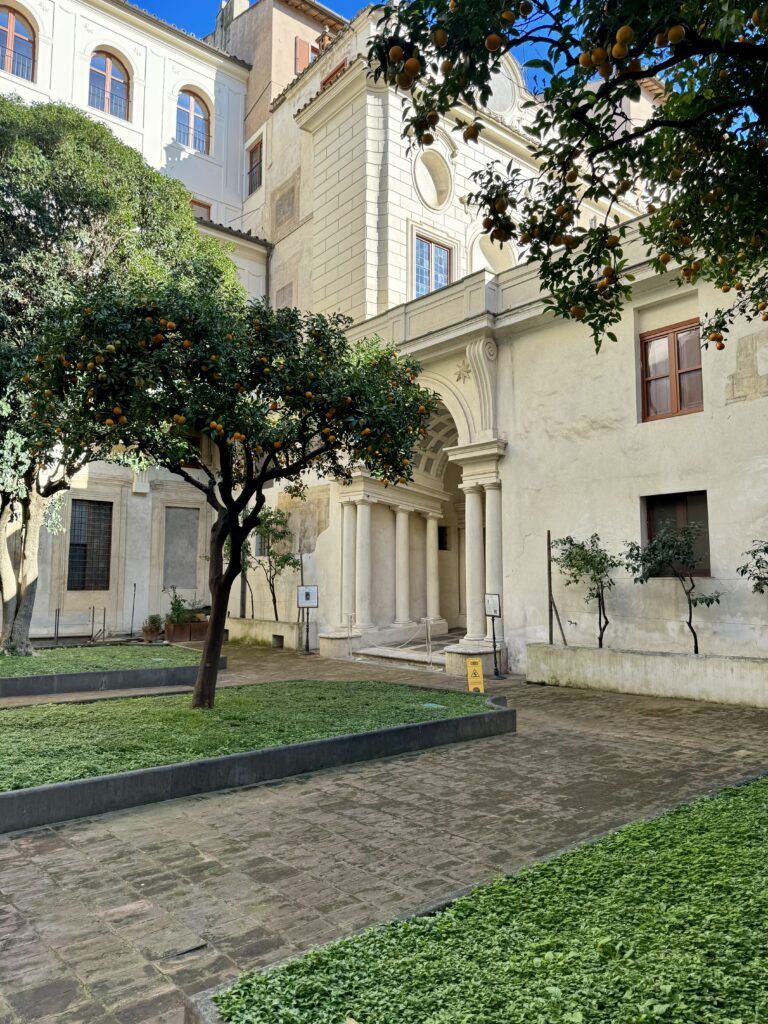
9. Borromini Perspective Gallery
The museum’s undisputed highlight is the internal garden courtyard, where you’ll find the Perspective Gallery.
When you’ve covered the four galleries, head back downstairs. A guide will escort you out to the courtyard. You can’t walk into the gallery, but the guide will explain how the perspective trick is achieved.
Cardinal Spada was fascinated with perspective tricks that evoked unlimited and unreal spaces. He wanted his small garden space to seem larger.
In 1652, he hired architect Francesco Borromini to create his very own optical illusion, an architectural folly of sorts.
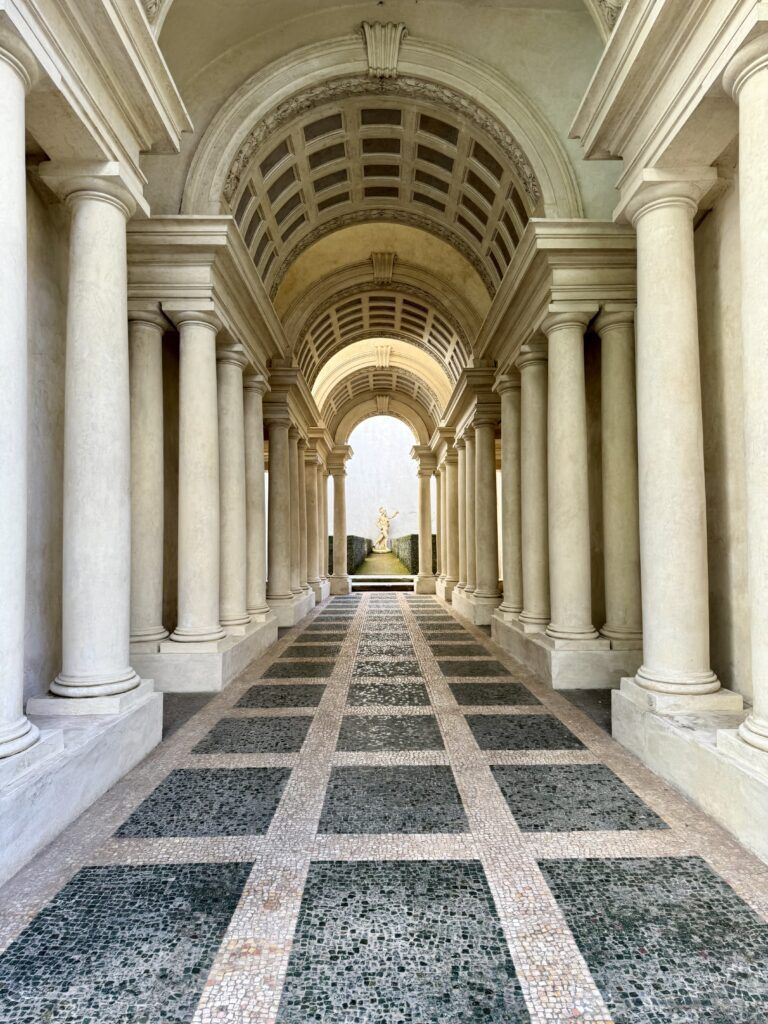
To help him with the tricky Perspective Gallery, Borromini hired an Augustinian priest who was known as a mathematical genius named Giovanni Maria da Bitonto.
Borromini completed the project in one year, between 1652 and 1653. The open air gallery has been called one of the “most ingenious artificialities of Baroque art.”
The long corridor of columns looks like a grand colonnade. But it isn’t what it appears. It seems endless, almost 120 feet long.
But it’s a trick of scale. The corridor is really only 26 feet in length. A towering sculpture is visible at the end. It looks life size, but it’s only 23 inches high.
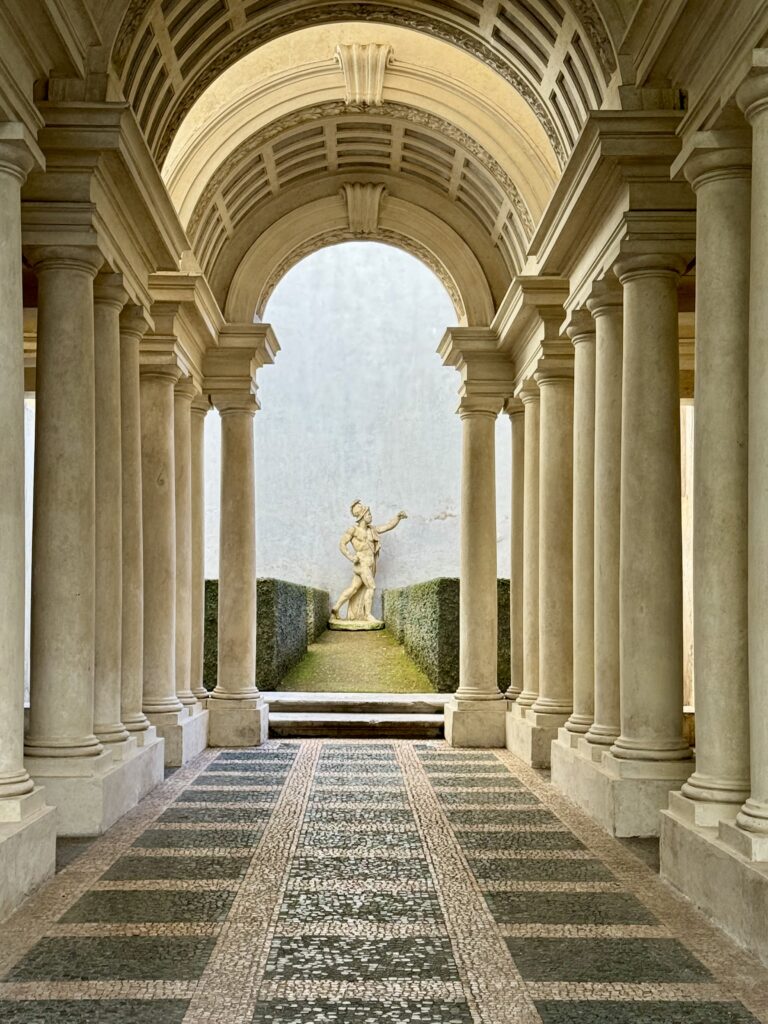
The misleading effect is created by the convergence of perspective planes toward a vanishing point, the sculpture of Mars. The floor rises, the ceiling lowers, the columns shorten, and the walls converge — all in a subtle way.
Even the bushes at the end of the corridor are an illusion. Borromini carved them himself out of stone to ensure the dimensions were accurate.
Originally, the corridor was flooded with light. Now, two of the three openings in the vault have been “restored” and mortared shut.
You can’t enter the gallery for preservation reasons. You stand at the end of the long corridor to view the illusion.
Practical Guide & Tips For Palazzo Spada
Right off the Via Giula, the Palazzo Spada is in the heart of Rome, just a block from Campo Dei Fiori (market) and Piazza Farnese.
The museum is located toward the back of Palazzo Spada. When you enter the building, walk through the courtyard and you’ll see signs for Galleria Spada. The entrance is on the left.
This is a fairly tiny gallery, so you don’t need too much time there. Perhaps just one hour.
Palazzo Spada is very close to Villa Farnesina (right across the Tiber River), another delightful Rome hidden gem with secret Raphael frescos.
Address: Piazza Campo di Ferro 13
Hours: Open daily from 8:30 am to 7:30 pm, closed Tuesdays. Last ticket at 7:00 pm.
Entry fee: € 6
Pro Tips:
Guided tours in English and Italian are available via prior booking or telephone 066832409. For details see website.
The paintings aren’t labeled, so it isn’t easy to identify them. Instead, they are numbered.
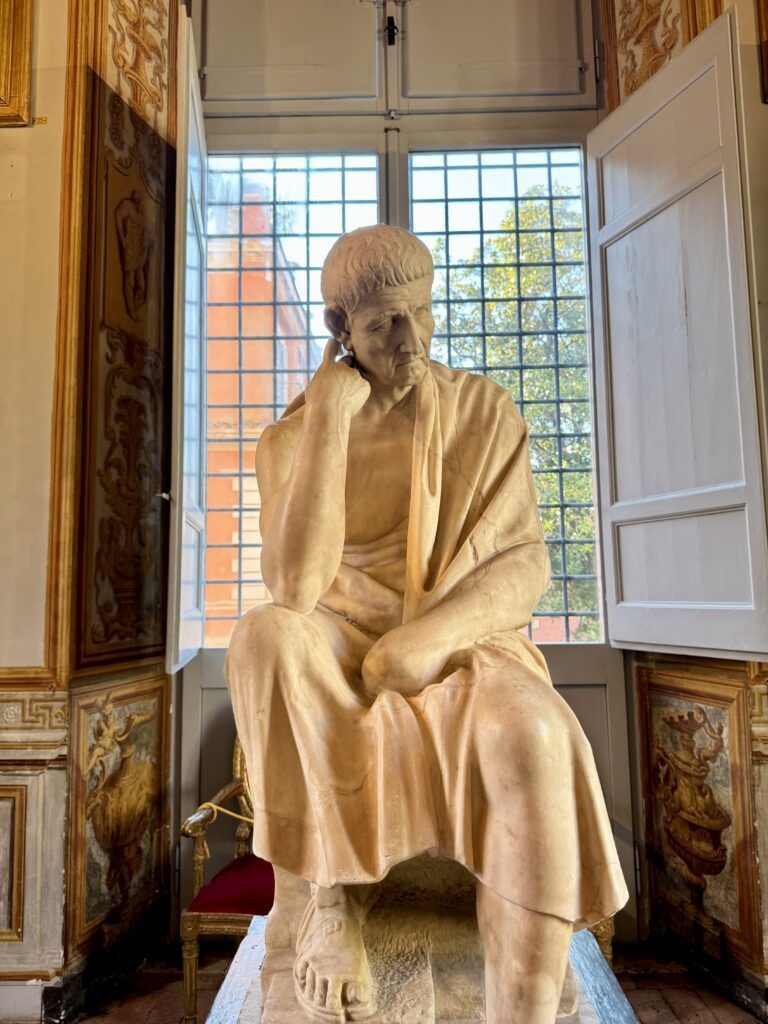
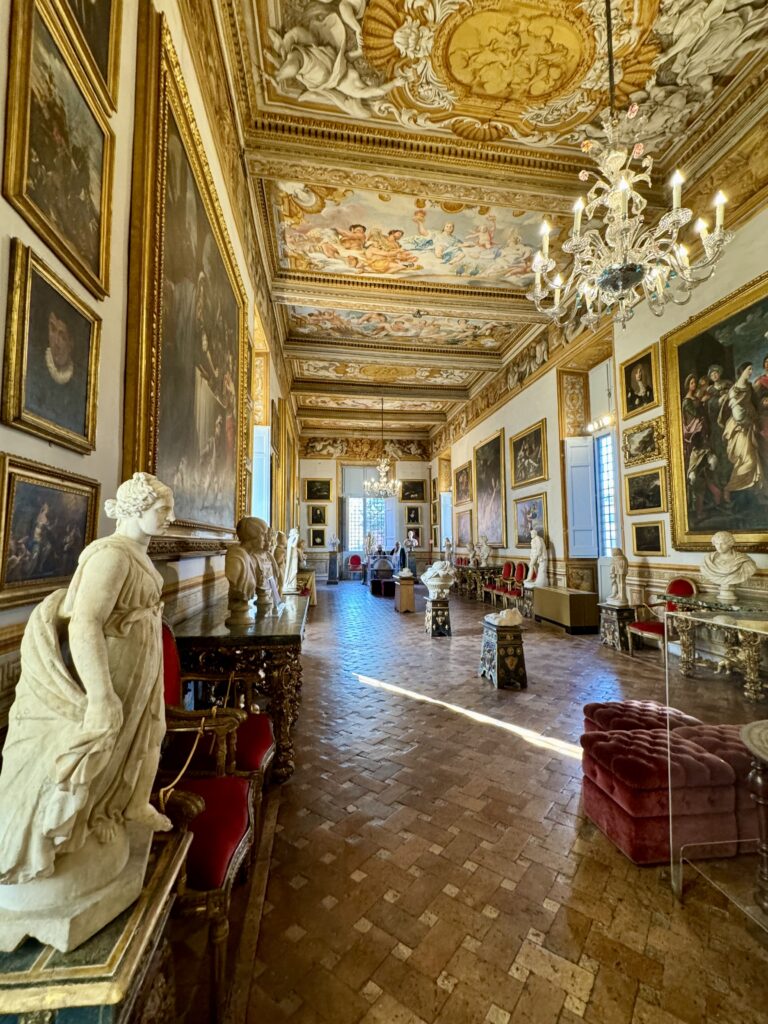
There is a numerical listing of paintings in each room. If you see a painting you like, you can check the number against the list to identify it.
If you’d like to explore more of the stunning art in Rome, check out my other guides:
- Bernini’s Art in Rome
- Caravaggio’s Art in Rome
- 20 Best Museums in Rome
- Guide to the Doria Pamphilj
- Guide to the Capitoline Museums
- Guide to the Palazzo Barberini
- Guide to Villa Farnesina
- Guide to the Borghese Gallery
- Must See Masterpieces at the Vatican
- Michelangelo’s Moses Sculpture
- Michelangelo’s Last Judgment
Pin it for later.
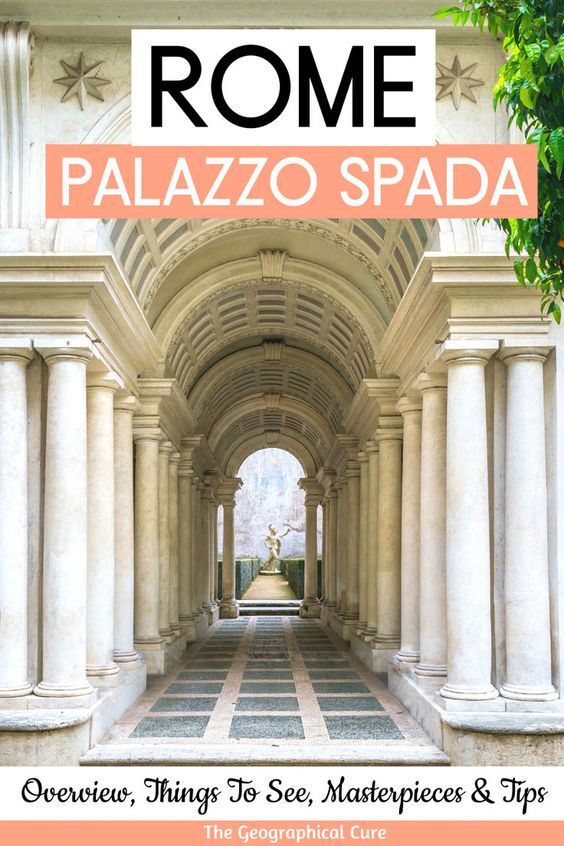

Thanks very informative. we are planning to visit Palazzo Spada in early September. Is it necessary to book, or can we just roll up?
I think you can probably just roll up in September.